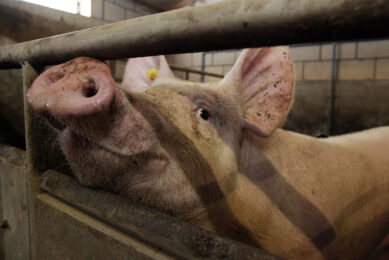Flaxseed and its nutritive value for pigs

Is flaxseed meal a good protein alternative for growing pigs? Researchers from Canada and the UK took a closer look at the nutritional value of this feed ingredient.
Flax (Linum usitatissimum) is a food crop that is widely grown in temperate regions for use in production of vegetable oil for human consumption. Flax crushing plants produce flaxseed meal (FM), a co-product produced when oil is extracted from flax seeds. Because FM is rich in α-linoleic acid, oil, protein and dietary fibre, it has received considerable interest as an alternative source of energy and amino acids (AA) in swine diets and as a functional feed ingredient for generating omega-3 fatty acids enriched pork and promoting gut health.
Experimental set up
The researchers sourced FM from Canada and fed this to a total of 9 ileal-cannulated [(Yorkshire-Landrace female × Duroc male)] barrows with an average initial BW of 46.0 ± 1.66 (±SD) kg.
The 3 diets used in this experiment included:
- a corn-soybean-based basal diet that was formulated to meet NRC (2012) nutrient recommendations for 50–75 kg pigs,
- a similar diet (Basal-FM) with a proportion of corn and soybean meal replaced with 278.35 g/kg FM, and
- a low nitrogen (N) casein and corn starch-containing diet (LND).
Attractive source for pigs
The total duration of the experiment was 33 days and during this period, urine and faecal samples were collected and analysed for dry matter, gross energy, N, AA, ether extract, aNDF and acid detergent fibre. The researchers conclude that FM is an attractive alternative source of dietary AA and energy that can be incorporated in swine diets to replace common protein sources. The use of FM is limited by its low lysine content as well as its dietary fibre content and the bulking capacity. The opportunity of incorporating FM in combination with other oilseed meals and exogenous enzymes during feed formulation for swine should be explored. More work is needed to determine the net energy content of FM using more accurate methods such as indirect calorimetry.
Join 26,000+ subscribers
Subscribe to our newsletter to stay updated about all the need-to-know content in the feed sector, three times a week. Beheer
Beheer









 WP Admin
WP Admin  Bewerk bericht
Bewerk bericht